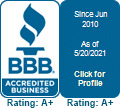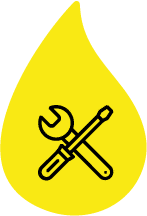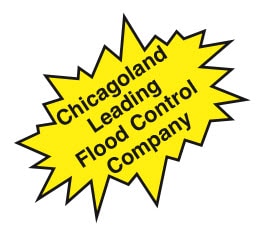parks' plumbing & Sewer FAQ
How Long Does It Take To Install the Flood Control?
Installation typically takes two to three days.
Do I need to be home during flood control installation?
You will only need to be home twice. The first time is when our plumber locates your sewer line and where the location of your Flood Control will be placed before digging starts. This is called the “Transmit.”
The second time is when the electrician comes to make the final connection. We call for appointments both times that you need be home. If the electrician needs to do a “Scope”, someone will need to be home for that also, but a “Scope” is not always called for.
If I am home when the crew is working, can I use water?
Yes, you can use the water. The crew might request for you to not use your water for half an hour while they are installing the valves. This includes laundry, toilet flushing, showers, and sinks. If they do not ask, then you can use your water as normal.
Why should I disconnect my downspout?
If your downspout runs into your sewer line, you can flood during heavy rains even with a Flood Control System. In most surrounding suburbs, it is the law that homes are to disconnect the downspouts as an environmental requirement of the Clean Water Act, which prohibits disposal of storm water into the sanitary sewer. In Chicago, City Code requires that all the downspouts be disconnected from your sewer line prior to the start of the job.
Will installing a flood control system ruin my lawn?
Parks’ does all hand digging and uses boards to protect your grass.
Do I need to do anything after the crew digs?
If your unit is installed in the Spring, Summer, or Fall, the grass should be watered thoroughly each day for 2-3 weeks starting the day the crew finishes the vault. This will help revive the grass and help it grow roots back into the ground.
How do I know if my system is working properly?
Your valves work mechanically in reaction to water pressure. To test your pump, open the Flood Control cover and run a hose into the small pit at the bottom where the pump is. The water should reach nearly the top of the pit and then activate the pump.
If the water rises over the pit and into the round overflow, please call our office. In addition, we strongly recommend that the Flood Control be “Cleaned and Checked” annually by one of our Techs.
What do I do once my Flood Control is installed?
Due to Federal Regulations regarding low flush toilets, low flow toilets, and downspout removal, Parks’ advises the use of toilet paper that breaks down in water.
Also, items such as plastic objects, feminine products, sanitary napkins, baby wipes, disposable diapers, paper towels, heavy-duty bath tissue and other such items should not find their way into your sewer line. These can jam your pump or valves and cause backup.
How do I make the final payment?
When the job is completed, our office will send you an itemized invoice that will act as your receipt. You can pay this invoice in person, by mail, or by calling us with your credit card information. If you have any questions, just call us!!! Thank you again for choosing Parks’ Plumbing!!
How Many Years Have You Been In Business?
We have been serving Chicago and the North, Northwest, and West Suburbs since 1981.
Should There be Water in the Pit?
Yes, water will always accumulate in the pit. This is minor ground seepage or residual wastewater and is normal.
Top 10 Reasons Why You Should Call A Plumber
1. Check under your sinks in the house for wet spots. Either along the pipes or underneath. You might have a leak.
2. Do you have low water pressure in your shower or in your kitchen? You could have a defective shower valve or pipes with build-up.
3. Take a close look at your water heater. How old is it? Can you detect rust or corrosion on the water heater or its connection to the pipes? Your water heater might be a ticking time bomb before it starts leaking.
4. Spray some soapy water onto the gas shut-off valve by the water heater. Do you see bubbles? You might have a gas leak.
5. Look for wet spots in the crawl space or attic. Do you see or smell mold? Leaking pipes often go undetected until they create harmful molds.
6. Check all of your shut-off valves and hose bibs. Do they turn easily without leaking? Do your valves need to be fixed or replaced? Could you shut them off in an emergency?
7. Check your toilet water tanks. Do you see any rust or green build up? Is your water tank leaking? Are you flushing gallons of water down the toilet without knowing because your tank is leaking?
8. Turn your water faucets on full power and shut them off quickly. Do you hear a noise or a bang in the pipes? You might have a “water-hammer”. A simple device can usually take care of this problem.
9. Do you know where your main water shut-off valve is? Do you know where your water meter is? Turn your main water shut-off valve to off and look at the water meter. Is it still turning? If the meter is still running, you might have a water leak somewhere that has been going undetected and is costing you lots of money in water bills.
10. Do you have any faucets that are dripping or have handles that are hard to turn? You might have calcium deposits or other build up causing your faucet to malfunction. Sometimes the faucet can be rebuilt or it is time to replace it.
If you can answer yes to any of these questions you are more or less likely to be in need of a plumber.
Call Parks Plumbing And Sewer Inc at: (847) 676-1931 right now, and we will take care of any of your plumbing problems.
What are your Opening Hours? When are you open?
Our regular hours are Monday through Friday 8:00am to 4:30pm. Emergency and after-hour services are available to some areas. See our Service Area map for more information.
What flood control systems and products do you offer?
We offer solutions for residential and commercial flooding systems including our patented Parks’ ‘DOUBLE GUARD’™ Flood Control System, which boasts a 99% success rate after over forty years of installations. Our valves in the system are all metal, with a cast iron housing and stainless steel parts. Other companies use a galvanized metal box with plastic parts and Styrofoam pieces. You definitely don’t want any plastic parts in a valve with that kind of pressure, especially not one that’s supposed to keep your house safe from City Sewer backup.
We have solutions for all kinds of water problems—basement seepage, yard drainage issues, sewer backups, etc. We also offer typical plumbing services and sewer repairs.
What is a French Drain? Why would I need one?
A French drain is a trench filled with rock or gravel that can hold a perforated pipe. The perforated hollow pipes along the bottom quickly vent water that seeps down through the gravel or rock bed.
French drains are primarily used to prevent ground and surface water from penetrating or damaging building foundations but can also be used to distribute water, such as a septic drain field at the outlet of a typical septic tank sewage treatment system. French drains can also be used behind retaining walls to relieve groundwater pressure.
What is a Residential Flood Control System?
A residential flood control system is any way(s) used to systematically reduce the risk of damage to a home or basement due to flooding. This flooding can be from basement cracks, floor drains or floors, through an overwhelmed catch basin, or even worse, up through the connection to the sewer system. This can mean something as simple as installing gutters and or French drains to divert rain water away from a residence, to an overhead sewer system which can stop sewers from backing up into a home when the village or city’s sewer is overwhelmed.
Some components may be catch basins, sump pumps, sewer backflow valves, overhead sewers, lift stations, backup sump pumps, battery backup systems for pumps, drain tile systems, French drains, or any number of other methods which are appropriate for a given property. Overland flooding is when water collects around the building and finds entry from without the structure through window wells, basement cracks, or even through doors or windows when the water is that high.
When do I make a payment for my Flood Control System?
When the men start working, please place a check or money order in an envelope and hand it to the Foreman. If you do not see the crew, you can mail or drop off the payment, but please advise us at the office if this is the case. You can also take care of the payment over the phone with a credit card.
When is the excess soil taken away?
It is scheduled for pick up the same day the digging portion is completed. Please note that the soil cannot be removed if it is raining or snowing.
When is the Sewer Rodding Done?
If you elected sewer rodding, which we recommend, it will be done during the digging portion of the work when the sewer pipe is open and before the valves are installed.
Where can I find some customer testimonials?
We have a few testimonials on our website as well as the video from Ask This Old House where Parks’ was featured.













